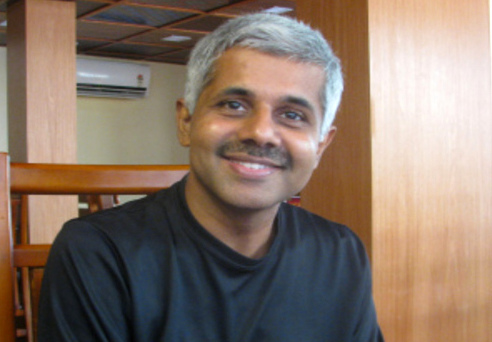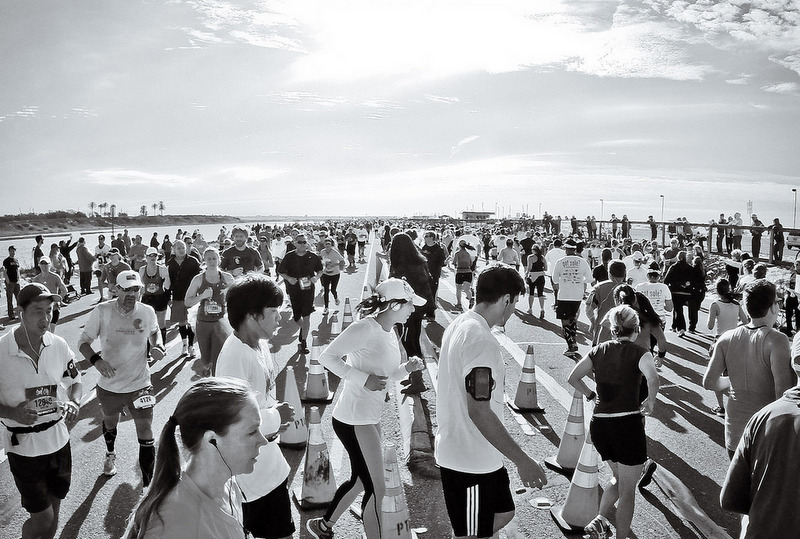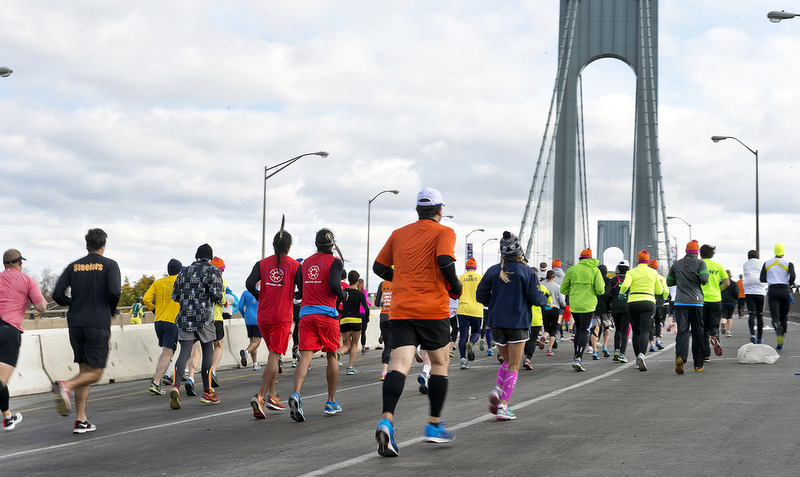11/07/2016
The café near Kaloor in Kochi had just opened for the day. But there was no hesitation over whether to serve a customer arrived early or not. I chose a table, ordered a cup of tea and waited for the subject of this article.
On Wikipedia, the page for Infosys says that the company had 194,044 employees as of March 2016. “Back then I was employee number 342, based in Bangalore,’’ Ramesh Kanjilimadhom said of his first job. Brief introduction aside, we had wasted no time in starting a conversation. Those were the pre-IPO days of Infosys; it was yet to become the household name synonymous with information technology that it would be in the years following IPO with shares listed and traded. Ramesh worked with Infosys over 1992-1993, then he joined Wipro GE Medical Imaging Systems. He left that in 1995 and shifted to the U.S., where he became part of a small company called Beechwood Data Systems in New Jersey. Until then, life had been relatively predictable, straightforward. He was born 1969 in Varandarappilly, a town near Thrissur in Kerala, to parents who were teachers; his father taught Malayalam at a college, his mother taught Malayalam at a school. “I never thought of myself as an athlete. I played cricket in school – that was it. My grandfather was a temple priest, my father was into literature – it was a highly literary household that I grew up in. There was no inclination toward athletics. I felt I wasn’t cut out for it,’’ Ramesh said. His schooling spanned three towns: Varandarappilly, Irinjalakkuda and Kothamangalam, leading up to a degree in engineering (Computer Science) from the Government Engineering College in Thrissur. Employee number 342 at Infosys was soon after that.
In the late 1990s, Ramesh’s elder brother was diagnosed with diabetes. Around the same time, his mother too was diagnosed with diabetes. When Ramesh went for his annual medical check-up, his doctor recommended that he do something to avert what appeared to be a genetic disposition in the family. Ramesh started running in Fairfax, Virginia; his daily mileage was 7-8 kilometers. He built it up to 12 kilometers once a week. “It was hard finding the motivation to do this,’’ Ramesh said. Luckily for him, Salvatore Messina, his boss at Beechwood, was a marathoner. He encouraged Ramesh to try longer distances. `Sal’ was passionate about the Marine Corps Marathon (MCM), held every year on the last Sunday of October, in Washington DC. The event begun by the U.S. armed forces in 1976, is currently deemed the sixth biggest marathon in the U.S. and 12th biggest in the world. Egged on by Sal, Ramesh enlisted for the 2006 MCM. He signed up six months ahead. For preparation he ran a local 20 kilometer race and also a 21 kilometer race. “At MCM there is something called ` Beat the Bridge,’ which is basically a bridge 32 kilometer into the race that must be crossed in 4-5 hours. I was aiming for a four hour-marathon. On the bridge I hit the proverbial wall and cramped up,’’ he said. Nevertheless, he completed the first full marathon of his life in 3 hours 47 minutes. Sal was sufficiently impressed by it to tell Ramesh that perhaps he should try the Boston Marathon. Ramesh didn’t take the suggestion seriously right then; instead he pursued the idea of a marathon in 3:30 and registered for the Carlsbad Marathon near San Diego in California. This was tougher than MCM. It was a hilly course. He finished in 3:46. “That second marathon taught me what a marathon entails,’’ he said. Persisting with the goal of 3:30, he then ran the Fredrick Marathon in Maryland. He trained for it. In 2007, he completed the run in 3:33. Now he began thinking of Boston.
Following that 3:33 at the Fredrick Marathon, Ramesh decided to do a Boston Qualifier (BQ). Those days, the qualifying time for his age group was 3:20. The BQ he chose was a race called Steamtown Marathon, held in Scranton, Pennsylvania. In retrospect, Ramesh thinks it isn’t the ideal BQ, for it is downhill most of the way with the last 3-4 kilometers being uphill. “I would think that ideally a BQ should be flat,’’ he said. The day of the 2007 Steamtown Marathon turned out to be hot. Same day, after the Chicago Marathon commenced, it was cancelled citing the heat. “I finished Steamtown in 3:28. But I still felt that I can do a 3:20,’’ he said. By this time, further changes had happened at work. Ramesh left Beechwood Data Systems in 2002; Beechwood would eventually be acquired by Capgemini. In 2004, he started a small company in league with his former boss at Beechwood. The company is called Seygen and Ramesh is one of its directors. Seygen develops software for telecom companies. Three weeks after Steamtown, he ran his second MCM and then shifted back to India with Seygen. In India, the company has offices in Kochi and Mumbai. Ramesh keeps traveling to the U.S. regularly, where Seygen has the other half of its operations.
In 2008, not long after returning to India, Ramesh ran his first Standard Chartered Mumbai Marathon (SCMM). He completed the full marathon in 3:36. Same year, he ran the St George Marathon in Utah. “It is a downhill course and Utah is beautiful. However it was extremely cold and windy, I also reached the venue later than expected thanks to some air travel problems,’’ Ramesh said. He finished the race in 3:28. After the run he was ill, shivering from the cold. He still remembers – the treat for runners after the race in that chilly weather, was an ice cream! Following the Utah event, he ran his third MCM. Three months later, while still searching for a BQ, he found himself with his children at Disney World. There, he ran the Disney World Marathon. It was a flat course, running from one Disney Park to another. Ramesh didn’t like that commercial aspect but he completed the race in 3:09. “It was the first race I ran without any walking,’’ he said. That year the qualifying time for his age group in Boston was 3:15. Ramesh’s timing from the Disney World Marathon was well within it.
In April 2009, he ran his first Boston Marathon. “It was a wonderful experience. Boston is great because of its spectators. You don’t see even 10 meters without spectators. The cheering is awesome. Then there is the Wellesley College portion of the course, which is called the `Scream Tunnel.’ It is a girls’ college and on race day they offer the runners free hugs and kisses. It is fun. Wellesley College is roughly around the 20 kilometer-mark. Between 26 kilometers and 32 kilometers there is a series of hills called Newton Hills, culminating in Heartbreak Hill. After Heartbreak Hill is Boston College. The Boston Marathon is like a big festival for the residents of the course,’’ Ramesh said recalling a race he evidently loves. He completed his first Boston Marathon in approximately 3:37. The experience seems to have taken a load off his chest, for he says, he settled down thereafter to enjoying his running. “I began running for the fun of it,’’ he said. Asked if he consciously managed the number of races he ran a year, he said, “I don’t hold back on races.’’ Ramesh has run 3-4 marathons in a month. When I met him in April 2016, he had already logged 52 marathons and three ultra-marathons.
Ramesh went on to run the Boston Marathon in 2010, 2013 and 2015. In 2015, he completed the course in 3:19. That was the year Thomas Bobby Philip from Bengaluru ran barefoot in Boston. “It was cold! I don’t know how he managed to do that,’’ Ramesh said, appreciating the effort. After his first Boston Marathon of 2009, Ramesh increased his mileage. In December 2009, he ran 550 kilometers; he said he recovers well after every long run. Roughly eight months after his first Boston Marathon, Ramesh began experimenting with barefoot running. In January 2010, Ramesh ran the Dubai Marathon wearing minimalist footwear. He completed it in 3:05. Since the 2010 Dubai Marathon, the majority of his running has been barefoot. “I am not an evangelist for barefoot running. How it works, varies from person to person. But you won’t know till you try it. I believe everyone should try it at least once,’’ Ramesh said.
The 2012 SCMM was special. Finishing it in 3:14, it was the first time Ramesh qualified for the Boston Marathon in India. Two weeks after that edition of the SCMM, he completed the Dubai Marathon in 3:08. That run in Dubai earned him entry to the New York Marathon of November 2012. In Kochi, Ramesh stays in Kakkanad. Friday, August 10 dawned with heavy rain. At 5.30 A.M., the hour Ramesh leaves for his daily ten mile-run, it was relatively dark save for the street lights on the road. “I try to finish my weekday runs in time to wish the kids before they get on the school bus,’’ Ramesh said. According to a report in The New Indian Express, that day Ramesh was running by in front of the Youth Hostel near NGO Quarters, when a car suddenly appeared from a side road and hit him on his left side. He landed on his face. The car didn’t stop. It accelerated and sped away. Ramesh tried to hold his leg, stand up and go to the nearest junction to get help. He couldn’t. “The accident broke the tibia and fibula of my left leg. My lower leg was dangling at an angle,’’ he said. As often happens in India, likely fearing the legal hassles that follow getting involved in the aftermath of an accident, no passing vehicle stopped to help Ramesh. Luckily, Rocky Roger, a BPO professional who had just finished his shift and was headed home, saw Ramesh. He stopped his car, picked up the injured runner and reached him to the hospital. X-rays revealed the multiple fractures.
The orthopedic surgeon at the hospital, decided to insert a steel rod to hold the fractured bones in place. Seema, Ramesh’s wife who had by then arrived, reminded the doctor of the patient’s love for running. The steel rod was traded for a titanium one. It was surgery, insertion of the titanium rod and end of the New York Marathon plan for time being. Interestingly, due to a hurricane, the New York Marathon of that year was cancelled. “I got back the money I had paid as entry fee,’’ Ramesh said. He was on crutches till early November. Mid-November 2012, he resumed running. For the 2013 SCMM, his preparation wouldn’t have exceeded 30 kilometers in all. He finished the full marathon in 4:07. I asked Ramesh about the surgery months before that SCMM, and his road to recovery. “The surgery was done only after my wife Seema arrived at the hospital and she alerted the doctor that I was a runner. So he used titanium rod which is lighter instead of the steel that they normally work with. I had the rod, plate and screws for about one and a half years. I ran fine with them. They were eventually removed in March 2014. My passage back to running was rather uneventful. I followed the instructions of the doctor and the physio to the tee. The good thing was the doctor was quite supportive of my running and he wanted me to get back to it quickly; so that helped. I started walking without crutches in a couple of months after the surgery and started running by late November. SCMM 2013 was hard because I had run no more than five to six times in the months preceding it, but it was a big confidence booster. I didn’t have any pain due to the surgery during or after the race, so didn’t have to look back,’’ Ramesh said.
In 2013, Ramesh’s friends Prasanna Kumar (aka A.P. Kumar; based in Kochi) and Manoj Kuriakose (based in Dubai) suggested that they start a running club. While this thought process was on, Ramesh got a call one day from Houston based-Mathew Mapram. He was calling from Kottayam. Mathew was a runner, around 68-69 years old then; he wanted to know what he could do to make running a lifestyle in Kerala. “That was a spark for the runners around to meet up. We decided to start a running group. Manoj came up with the name: Soles of Cochin. The group started in July 2013 and its growth has been amazing, not just in terms of numbers but also in terms of passion for the sport. We don’t leave out any race anywhere. We just go and run everywhere. We make a lot of noise. We have now become a synonym for being crazy runners,’’ Ramesh said. In Kochi, the group trains four days a week. They have a tempo run on Tuesday; a hill run on Thursday, a long run on Saturday and a beginners’ run plus recovery phase on Sunday. “We’ve supported long runs but nothing like Mumbai Road Runners’ monthly Bandra-NCPA run in Mumbai. We want to get to that level though,’’ Ramesh said. However Soles of Cochin has three full-fledged events that it organizes. In January, it holds the Puttumanoor Race (21 kilometers, 10 kilometers, five kilometers), in May it holds the Spice Farms Race (21 kilometers, 10 kilometers, five kilometers) and in November, it conducts the Spice Coast Marathon (42 kilometers, 21 kilometers, five kilometers). In between, it also organizes trail runs in Munnar, Vagamon and Lower Periyar. Two weeks before I met Ramesh, Soles of Cochin had organized the Night Owls Ultra, a 12 hour-run at night on Willingdon Island (home to Kochi’s port). “We want to do it more often. Maybe do it in monsoon; March was hot,’’ he said laughing.
At the 2015 Mumbai Ultra (a supported non-competitive 12 hour-endurance run held annually in Mumbai) I met Naushad Asanar and Vijayan Pillai, both Kochi based-runners and members of Soles of Cochin. According to Naushad, Ramesh, who is much respected in Kochi’s running scene, prefers to keep a low profile. He sports a simplicity acquired from years of running. “He is not crazy about gear. At the events we organize, he plays his role but stays in the backdrop. Others may pitch to invite celebrities for a running event to create some buzz. Ramesh is rarely part of such trends, for him running is what matters,’’ Naushad said, adding, that simplified, functional view of running has influenced the group. “We see Ramesh as a guide. He has done a lot of running, yet he is humble. Although someone who shuns the limelight, he is a very open person and newcomers to the sport learn much talking to him. If you go for a run with him, his love for the sport rubs off on you,’’ Vijayan said.
Ramesh completed the 2015 SCMM in 3:04. In 2016 he ran the Boston Marathon again, this time barefoot and completing it in 3:11:54, his best timing yet at the event. Six days later, he ran the Big Sur Marathon in California, “one of the most scenic marathons in the world,’’ although Ramesh who ran it barefoot does not deem it ideal for barefoot running given road conditions. But it was an event he ran earlier in 2016 that set him thinking. He finished the 2016 Dubai Marathon in 3:02. It got him interested in the possibility of running a sub three-hour marathon. He knows that although a mere three minutes separates 3:02 from sub-three, getting there will be challenging. “I can plan to push myself for a sub-three perhaps by January 2017,’’ he said. For now the Houston Marathon appears a good event to try this. In the meantime, he is trying to build up his strength and endurance.
(This article originally appeared in Shyam G Menon's blog `Outrigger': https://shyamgopan.
Photo credits: Martins Zemlickis/Unsplash, Shyam G. Menon, B.Positive.2014 via Foter.com / CC BY-SA MTAPhotos via Foter.com / CC BY



